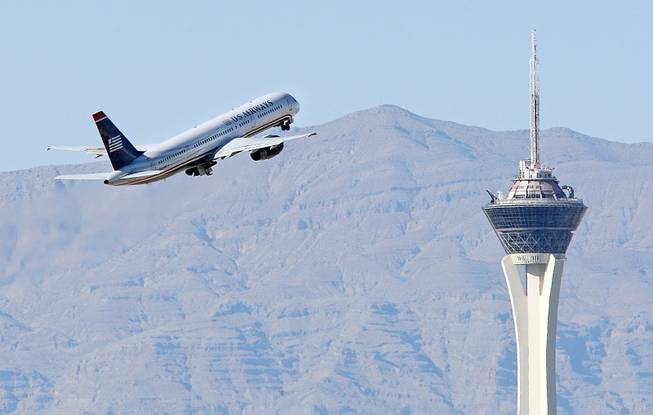Monday, April 6, 2009 | 2 a.m.
Sun Archives
US Airways, the second-busiest airline at McCarran International Airport, has a game plan for profitability.
Unfortunately for Las Vegas, its plan includes contraction — not expansion — in Southern Nevada.
Reducing flights increases the value of available seats and enables airlines to charge more for tickets. In past recessions, low-cost carriers have taken advantage of this move by other carriers to steal market share and grow.
But in this recession, few carriers have the resources to grow. Even Southwest Airlines, McCarran’s busiest carrier and one of the few airlines that has consistently made money, is cutting capacity. That gives US Airways hope that capacity will continue to fall and enable it to make money this year.
High-profile airline mergers are one of the most aggressive ways to trim capacity, and US Airways’ management is among the most vocal advocates of mergers as a means to trim what it considers an oversupply of seats.
US Airways and America West Airlines merged in 2005. Before the ink had dried on that deal, the new US Airways was involved in a hostile takeover bid for Atlanta-based Delta Air Lines. Although the bid failed, US Airways leadership thinks its efforts drove the recently completed merger of Delta and Northwest Airlines.
Between those mergers and the discontinuation of operations by airlines such as Aloha, ATA and Skybus, capacity has dropped to a level that is making US Airways CEO Doug Parker optimistic about his company’s future, even though it lost $803 million in 2008. Parker says for the industry and his airline to make money, the business model has to change.
In addition to mergers and shutdowns, several airlines, including US Airways, have been aggressive in trimming schedules. US Airways capacity cuts have hit Las Vegas hard.
Before the merger, McCarran was one of two hub airports for America West. Almost every flight went through either Phoenix or Las Vegas.
The airline took advantage of Las Vegas’ 24-hour lifestyle and flew a majority of its operations to and from McCarran after 8 p.m. Passengers were offered lower fares if they traveled late, and the system resulted in the airline having more than 130 daily flights to more destinations than any other carrier serving Las Vegas.
When America West’s biggest rival, Southwest, expanded in Las Vegas as the community grew in the 1990s, the competition became even more intense. The two dominated the market, and the rivalry spurred fare wars that kept ticket prices low.
When the merger occurred, US Airways initially said it would continue to use Phoenix and Las Vegas as hubs, along with its established East Coast operations in Pittsburgh, Philadelphia and Charlotte, N.C.
But the airline dramatically reduced its presence in Pittsburgh, focusing on Charlotte and Philadelphia. When oil prices surged last summer, the airline reevaluated the Las Vegas night hub concept and determined it no longer made economic sense. Even with full aircraft, the airline wasn’t making enough money to justify the flights.
After the night hub was shut down, the airline intensified its bid to cut capacity as a way to make money. Las Vegas was an easy target because its leisure market position wasn’t as profitable as business travel markets such as Philadelphia.
Las Vegas’ primary business travel component — conventions — isn’t like traditional business travel because convention attendees, like leisure travelers, book flights in advance and are less likely to purchase tickets for higher-priced, spur-of-the-moment trips. Airlines generate most of their profits from business travelers who buy at the last minute.
Today US Airways has about half the flights it once had in Las Vegas — an average of 69 a day. In the past 12 months, the local operation has contracted by 34.8 percent. The airline no longer refers to Las Vegas as one of its primary destinations, and most US Airways flights are point to point, like those of rival Southwest.
“Vegas was one of the hardest hit (destinations) in the system,” said Robert Isom, executive vice president and chief operating officer. “But any flights that we pulled were money losers.”
Isom said even though fuel costs have come down, the airline is focused on becoming profitable and customers haven’t been rushing to book flights in the down economy. The lower demand resulted in decisions to cut capacity more in Las Vegas.
Fewer operations at McCarran translated into job cuts. The airline offered to transfer Las Vegas employees to other cities, but its local workforce was different from the workforces in traditional markets.
Donna Paladini, vice president for the airport customer service, said reducing the number of Las Vegas employees by about 60 in February has left a little more than 500 workers.
“The majority of the employees that left were part-time workers just because of the nature of our operation there,” Paladini said. “A lot of those folks were working full time at hotels and part time with us to get the flying benefits.”
Because many workers had other Las Vegas jobs, few accepted transfers.
US Airways hasn’t been alone in cutting capacity in Las Vegas. McCarran’s peak capacity occurred in October 2007, when there were 8,212 flights a week and 1,159,580 seats in and out of the market. March’s capacity was 7,024 weekly flights and 1,007,655 seats — a 14.5 percent flight and 13.1 percent seat decrease.
A version of this story appeared in this week’s In Business Las Vegas, a sister publication of the Las Vegas Sun.


Join the Discussion:
Check this out for a full explanation of our conversion to the LiveFyre commenting system and instructions on how to sign up for an account.
Full comments policy